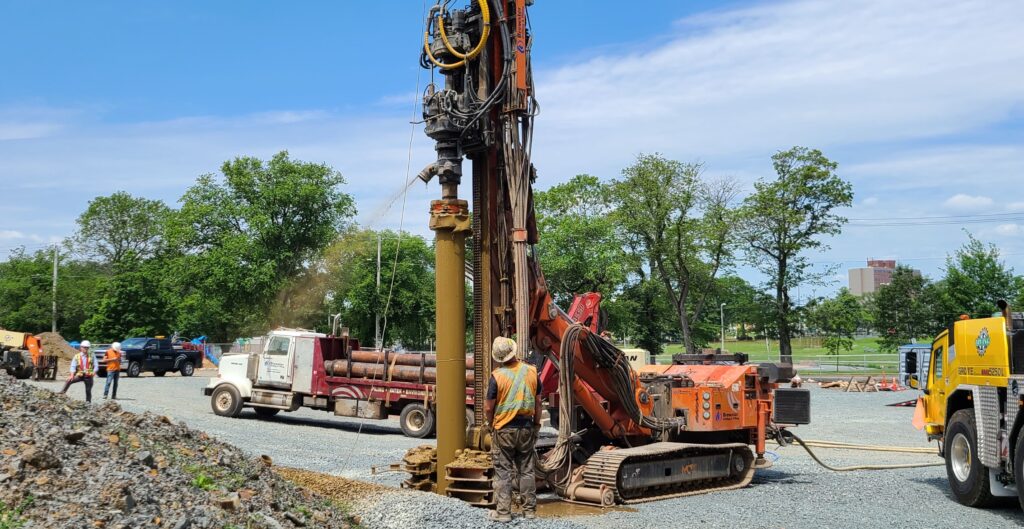
How to Control Construction Noise and Vibration on Sensitive Projects
Construction is synonymous with noise and vibration. There is no disputing it. However, in certain situations, noise and vibration can and must be controlled. Not only can it cause damage to property, but it can interfere with sensitive equipment such as MRI or CT machines at a nearby hospital.
While bylaws vary by city, Toronto requires you to complete a vibration control form before securing a building permit. Generally, the permit process in most municipalities, including Toronto, is focused on structural damage to nearby buildings or services. It does not take into account the impact on uniquely sensitive uses like patient bedrooms or equipment in healthcare settings, recording studios, or an art gallery housing delicate artifacts. This gap in the municipal requirements can be problematic. Excessive vibration close to a gas line could be disastrous. Near a broadcast studio, it can impact a live or taped event. Near a hospital, it could interfere with sensitive diagnostic equipment.
Our team at Aercoustics is often called upon to provide noise and vibration management to help mitigate the impact of construction on sensitive neighbours. The typical case is for architectural renovation projects within sensitive buildings. Often there are minimal or no guidelines that apply within one’s own space, which adds to the challenge of an interior renovation. While we do conduct vibration monitoring during the project, there is a critical step that must be taken at the outset of the project to better control the noise and vibration generated during construction. Part of this includes conducting in-situ vibration studies to measure and predict how vibration propagates across a site or through a building.
Aercoustics developed project specific protocols to better control the noise and vibration that could be generated during the construction of two recent projects: Mount Sinai Hospital Renewal Phase III (Toronto) and the QEII Halifax Infirmary Hospital Renovation/New Build (Halifax). In both projects, there were several ways the protocol could go, and the client directed how much control they desired.
Examples of Past Protocols to Manage Noise and Vibration
Protocols and controls will be specific to the project and will vary from one site to another. Depending on the sensitivities and client expectations, some of our past protocols have included:

- Development of reasonable noise and vibration limits. The contractor must advise of any excessive noise or vibration inducing activities at least eight weeks beforehand to allow the sponsors to make alternate arrangements to relocate staff or programming to be away from these activities.
- Strict noise and vibration limits that must be met at all times by the contractor. One challenge with this is that it may eliminate some construction activities outright, which can adversely impact the contractor’s efficiency and the project schedule.
- Requirement for acoustically designed hoarding barriers to mitigate noise transmission.
Best Practices for Establishing Noise and Vibration Management Protocols
Here are a few things to keep in mind before establishing protocols for your project:

- Identify priorities and sensitivities: It is important to have a discussion with the sponsors in terms of the priorities and sensitivities. Often more control can mean reduced construction techniques available. This may provide quieter and more manageable noise and vibration levels but can require longer schedules and increased costs. Whereas more tolerance of noise and vibration levels can mean shorter construction durations. If the priority is to ensure minimal noise and vibration, then the client must be aware that this will impact timelines and costs.
- Involve all key stakeholders: It is very important to create these protocols in collaboration with the project sponsors and stakeholders. The best outcomes are realized when the contractor and sponsors are collaborative. Construction is a messy and sometimes unpredictable operation, so a willingness to adjust sponsor programs or construction schedules to accommodate all parties is very important.
- Establish protocols at the outset: It is paramount the protocols and requirements be established at the beginning of a project. If protocols are not clearly defined and incorporated into the contractual framework of a project, then it becomes very difficult if noise and vibration issues are discovered later. Without a contractually enforceable set of requirements, there is the risk that imposing this later will invite delay of schedule claims from the contractor, which can be very costly.
A more restrictive set of requirements has the potential to elongate a construction schedule, which has an obvious cost implication. But if this is considered early on, then a costing analysis can be done to evaluate the benefits and drawbacks of a longer construction schedule versus temporarily vacating a space (or eliminating certain sensitive activities in these spaces) to allow construction to occur with fewer restrictions.
Future of Construction Noise and Vibration
As cities like Toronto grow in density, heavy construction is being brought closer and closer to sensitive buildings so the demand for these services will only increase. Having a clear and direct protocol allows the project contractor to accurately assess expectations and build a construction schedule that takes this into account as part of their competitive bid. It also gives the project sponsors the confidence their needs have been protected, and there is the contractual framework in place to enforce those needs if issues arise.
